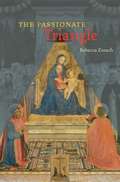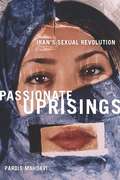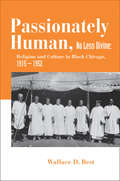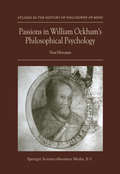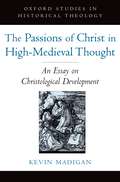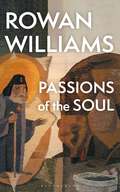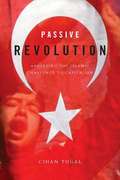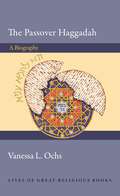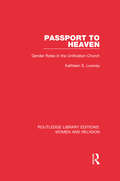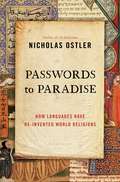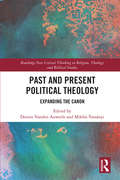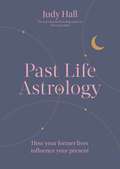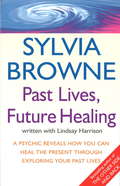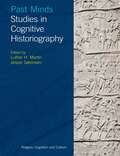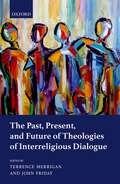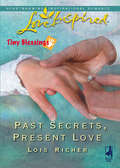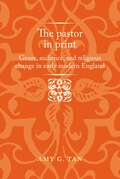- Table View
- List View
The Passionate Triangle
by Rebecca ZorachTriangles abounded in the intellectual culture of early modern Europe—the Christian Trinity was often mapped as a triangle, for instance, and perspective, a characteristic artistic technique, is based on a triangular theory of vision. Renaissance artists, for their part, often used shapes and lines to arrange figures into a triangle on the surface of a painting—a practice modern scholars call triangular composition. But is there secret meaning in the triangular arrangements artists used, or just a pleasing symmetry? What do triangles really tell us about the European Renaissance and its most beguiling works of art? In this book, Rebecca Zorach takes us on a lively hunt for the triangle’s embedded significance. From the leisure pursuits of Egyptian priests to Jacopo Tintoretto’s love triangles, Zorach explores how the visual and mathematical properties of triangles allowed them to express new ideas and to inspire surprisingly intense passions. Examining prints and paintings as well as literary, scientific, and philosophical texts, The Passionate Triangle opens up an array of new ideas, presenting unexpected stories of the irrational, passionate, melancholic, and often erotic potential of mathematical thinking before the Scientific Revolution.
The Passionate Triangle
by Rebecca ZorachTriangles abounded in the intellectual culture of early modern Europe—the Christian Trinity was often mapped as a triangle, for instance, and perspective, a characteristic artistic technique, is based on a triangular theory of vision. Renaissance artists, for their part, often used shapes and lines to arrange figures into a triangle on the surface of a painting—a practice modern scholars call triangular composition. But is there secret meaning in the triangular arrangements artists used, or just a pleasing symmetry? What do triangles really tell us about the European Renaissance and its most beguiling works of art? In this book, Rebecca Zorach takes us on a lively hunt for the triangle’s embedded significance. From the leisure pursuits of Egyptian priests to Jacopo Tintoretto’s love triangles, Zorach explores how the visual and mathematical properties of triangles allowed them to express new ideas and to inspire surprisingly intense passions. Examining prints and paintings as well as literary, scientific, and philosophical texts, The Passionate Triangle opens up an array of new ideas, presenting unexpected stories of the irrational, passionate, melancholic, and often erotic potential of mathematical thinking before the Scientific Revolution.
The Passionate Triangle
by Rebecca ZorachTriangles abounded in the intellectual culture of early modern Europe—the Christian Trinity was often mapped as a triangle, for instance, and perspective, a characteristic artistic technique, is based on a triangular theory of vision. Renaissance artists, for their part, often used shapes and lines to arrange figures into a triangle on the surface of a painting—a practice modern scholars call triangular composition. But is there secret meaning in the triangular arrangements artists used, or just a pleasing symmetry? What do triangles really tell us about the European Renaissance and its most beguiling works of art? In this book, Rebecca Zorach takes us on a lively hunt for the triangle’s embedded significance. From the leisure pursuits of Egyptian priests to Jacopo Tintoretto’s love triangles, Zorach explores how the visual and mathematical properties of triangles allowed them to express new ideas and to inspire surprisingly intense passions. Examining prints and paintings as well as literary, scientific, and philosophical texts, The Passionate Triangle opens up an array of new ideas, presenting unexpected stories of the irrational, passionate, melancholic, and often erotic potential of mathematical thinking before the Scientific Revolution.
The Passionate Triangle
by Rebecca ZorachTriangles abounded in the intellectual culture of early modern Europe—the Christian Trinity was often mapped as a triangle, for instance, and perspective, a characteristic artistic technique, is based on a triangular theory of vision. Renaissance artists, for their part, often used shapes and lines to arrange figures into a triangle on the surface of a painting—a practice modern scholars call triangular composition. But is there secret meaning in the triangular arrangements artists used, or just a pleasing symmetry? What do triangles really tell us about the European Renaissance and its most beguiling works of art? In this book, Rebecca Zorach takes us on a lively hunt for the triangle’s embedded significance. From the leisure pursuits of Egyptian priests to Jacopo Tintoretto’s love triangles, Zorach explores how the visual and mathematical properties of triangles allowed them to express new ideas and to inspire surprisingly intense passions. Examining prints and paintings as well as literary, scientific, and philosophical texts, The Passionate Triangle opens up an array of new ideas, presenting unexpected stories of the irrational, passionate, melancholic, and often erotic potential of mathematical thinking before the Scientific Revolution.
Passionate Uprisings: Iran's Sexual Revolution
by Pardis MahdaviThere is perhaps no place in the world today where the stakes of partying and having sex are higher than in present-day Iran. Drinking and dancing can lead to arrest by the morality police and a punishment of up to 70 lashes. Consequences for sex outside of marriage can be even more severe—up to 84 lashes, or even public execution. But even under the threat of such harsh punishment, a sexual revolution is taking place. Iranian youth continually risk personal safety to meet friends, date, and, ultimately, to have sex. In the absence of any option for overt political dissent, young people have become part of a self-proclaimed revolution in which they are using their bodies to make social and political statements. Sex has become both a source of freedom and an act of political rebellion. With unprecedented access inside turn-of-the century Iran, Pardis Mahdavi offers a firsthand look at the daily lives of Iranian youth. They are given a voice as she tells the stories of their intertwined quests for sexual freedom, political reform, and a better future—but not a future without risk. The sexual revolution is also leading to increased levels of abortion, HIV/AIDS, sexually transmitted diseases, and ongoing emotional troubles and mental illnesses, with worrying implications for Iranian youth and Iranian society at large. Passionate Uprisings is a fascinating, ground-breaking, and personal look into a society that is poorly understood—if it is understood at all—by the majority of Westerners today. Mahdavi's narrative provides not only an invaluable insight into the real lives of much of Iran's population, but shows how sexual politics and the youth culture could even destabilize the current regime and change the course of Iranian politics.
Passionately Human, No Less Divine: Religion and Culture in Black Chicago, 1915-1952
by Wallace D. BestThe Great Migration was the most significant event in black life since emancipation and Reconstruction. Passionately Human, No Less Divine analyzes the various ways black southerners transformed African American religion in Chicago during their Great Migration northward. A work of religious, urban, and social history, it is the first book-length analysis of the new religious practices and traditions in Chicago that were stimulated by migration and urbanization. The book illustrates how the migration launched a new sacred order among blacks in the city that reflected aspects of both Southern black religion and modern city life. This new sacred order was also largely female as African American women constituted more than 70 percent of the membership in most black Protestant churches. Ultimately, Wallace Best demonstrates how black southerners imparted a folk religious sensibility to Chicago's black churches. In doing so, they ironically recast conceptions of modern, urban African American religion in terms that signified the rural past. In the same way that working class cultural idioms such as jazz and the blues emerged in the secular arena as a means to represent black modernity, he says, African American religion in Chicago, with its negotiation between the past, the present, rural and urban, revealed African American religion in modern form.
Passions in William Ockham’s Philosophical Psychology (Studies in the History of Philosophy of Mind #2)
by Vesa HirvonenThe Passions of Christ in High-Medieval Thought: An Essay on Christological Development (Oxford Studies in Historical Theology)
by Kevin MadiganSince the earliest days of the Church, theologians have struggled to understand how humanity and divinity coexisted in the person of Christ. Proponents of the Arian heresy, which held that Jesus could not have been fully divine, found significant scriptural evidence of their position: Jesus wondered, questioned, feared, suffered, and prayed. The defenders of orthodoxy, such as Hilary of Poitiers, Ambrose of Milan, Jerome, and Augustine, showed considerable ingenuity in explaining how these biblical passages could be reconciled with Christ's divinity. Medieval theologians such as Peter Lombard, Thomas Aquinas, and Bonaventure, also grappled with these texts when confronting the rising threat of Arian heresy. Like their predecessors, they too faced the need to preserve Jesus' authentic humanity and to describe a mode of experiencing the passions that cast no doubt upon the perfect divinity of the Incarnate Word. As Kevin Madigan demonstrates, however, they also confronted an additional obstacle. The medieval theologians had inherited from the Greek and Latin fathers a body of opinion on the passages in question, which by this time had achieved normative cultural status in the Christian tradition. However, the Greek and Latin fathers wrote in a polemical situation, responding to the threat to orthodoxy posed by the Arians. As a consequence, they sometimes found themselves driven to extreme and sometimes contradictory statements. These statements seemed to their medieval successors either to compromise the true divinity of Christ, his true humanity, or the possibility that the divine and human were in communication with or metaphysically linked to one another. As a result, medieval theologians also needed to demonstrate how two equally authoritative but apparently contradictory statements could be reconciled-to protect their patristic forebears from any doubt about their unanimity or the soundness of their orthodoxy. Examining the arguments that resulted from these dual pressures, Madigan finds that, under the guise of unchanging assimilation and transmission of a unanimous tradition, there were in fact many fissures and discontinuities between the two bodies of thought, ancient and medieval. Rather than organic change or development, he finds radical change, trial, novelty, and even heterodoxy.
Passions of the Soul
by The Right Revere Rowan WilliamsThe Eastern Christian tradition is filled with theological and spiritual riches. In Passions of the Soul, Rowan Williams opens up the great classics of Eastern Christian writing to show how it can help us to understand and cope with the ups and downs of modern life.With compelling and illuminating insight, he shows the cost of living in a culture that is theologically and philosophically undernourished, working with a diminished and trivialized picture of the human self. The Eastern tradition teaches us how to develop our self-knowledge and awareness, so that we can relate to the world without selfish illusions. Only then can we be ready for our eyes to be opened to God, and avoid destructive patterns of behaviour. Only in this way can we understand the kind of people we need to become.
Passive Revolution: Absorbing the Islamic Challenge to Capitalism
by Cihan TuğalOver the last decade, pious Muslims all over the world have gone through contradictory transformations. Though public attention commonly rests on the turn toward violence, this book's stories of transformation to "moderate Islam" in a previously radical district in Istanbul exemplify another experience. In a shift away from distrust of the state to partial secularization, Islamists in Turkey transitioned through a process of absorption into existing power structures. With rich descriptions of life in the district of Sultanbeyli, this unique work investigates how religious activists organized, how authorities defeated them, and how the emergent pro-state Justice and Development Party incorporated them. As Tuğal reveals, the absorption of a radical movement was not simply the foregone conclusion of an inevitable world-historical trend but an outcome of contingent struggles. With a closing comparative look at Egypt and Iran, the book situates the Turkish case in a broad historical context and discusses why Islamic politics have not been similarly integrated into secular capitalism elsewhere.
The Passover Haggadah: A Biography (Lives of Great Religious Books #51)
by Vanessa OchsThe life and times of a treasured book read by generations of Jewish families at the seder tableEvery year at Passover, Jews around the world gather for the seder, a festive meal where family and friends come together to sing, pray, and enjoy traditional food while retelling the biblical story of the Exodus. The Passover Haggadah provides the script for the meal and is a religious text unlike any other. It is the only sacred book available in so many varieties—from the Maxwell House edition of the 1930s to the countercultural Freedom Seder—and it is the rare liturgical work that allows people with limited knowledge to conduct a complex religious service. The Haggadah is also the only religious book given away for free at grocery stores as a promotion. Vanessa Ochs tells the story of this beloved book, from its emergence in antiquity as an oral practice to its vibrant proliferation today.Ochs provides a lively and incisive account of how the foundational Jewish narrative of liberation is remembered in the Haggadah. She discusses the book's origins in biblical and rabbinical literature, its flourishing in illuminated manuscripts in the medieval period, and its mass production with the advent of the printing press. She looks at Haggadot created on the kibbutz, those reflecting the Holocaust, feminist and LGBTQ-themed Haggadot, and even one featuring a popular television show, The Marvelous Mrs. Maisel. Ochs shows how this enduring work of liturgy that once served to transmit Jewish identity in Jewish settings continues to be reinterpreted and reimagined to share the message of freedom for all.
The Passover Haggadah: A Biography (Lives of Great Religious Books #51)
by Vanessa L. OchsThe life and times of a treasured book read by generations of Jewish families at the seder tableEvery year at Passover, Jews around the world gather for the seder, a festive meal where family and friends come together to sing, pray, and enjoy traditional food while retelling the biblical story of the Exodus. The Passover Haggadah provides the script for the meal and is a religious text unlike any other. It is the only sacred book available in so many varieties—from the Maxwell House edition of the 1930s to the countercultural Freedom Seder—and it is the rare liturgical work that allows people with limited knowledge to conduct a complex religious service. The Haggadah is also the only religious book given away for free at grocery stores as a promotion. Vanessa Ochs tells the story of this beloved book, from its emergence in antiquity as an oral practice to its vibrant proliferation today.Ochs provides a lively and incisive account of how the foundational Jewish narrative of liberation is remembered in the Haggadah. She discusses the book's origins in biblical and rabbinical literature, its flourishing in illuminated manuscripts in the medieval period, and its mass production with the advent of the printing press. She looks at Haggadot created on the kibbutz, those reflecting the Holocaust, feminist and LGBTQ-themed Haggadot, and even one featuring a popular television show, The Marvelous Mrs. Maisel. Ochs shows how this enduring work of liturgy that once served to transmit Jewish identity in Jewish settings continues to be reinterpreted and reimagined to share the message of freedom for all.
Passport to Heaven: Gender Roles in the Unification Church (Routledge Library Editions: Women and Religion)
by Kathleen S. LowneyThis book focuses on the gender roles within the Unification Church, and on particularly the gender roles as expressed through the vows of marriage. It examines the more widely shared patriarchal assumptions about women in a circumscribed socio-religious environment, with the Church’s gender role system being investigated largely on the level of its theological explanations for gender roles. The Church’s ethos, its lived reality, is also examined, and for this many interviews have been conducted with the ‘blessed’, the married couples. First published in 1992.
Passport to Heaven: Gender Roles in the Unification Church (Routledge Library Editions: Women and Religion)
by Kathleen S. LowneyThis book focuses on the gender roles within the Unification Church, and on particularly the gender roles as expressed through the vows of marriage. It examines the more widely shared patriarchal assumptions about women in a circumscribed socio-religious environment, with the Church’s gender role system being investigated largely on the level of its theological explanations for gender roles. The Church’s ethos, its lived reality, is also examined, and for this many interviews have been conducted with the ‘blessed’, the married couples. First published in 1992.
Passwords to Paradise: How Languages Have Re-invented World Religions
by Nicholas Ostler"In the beginning was the Word, and the Word was with God, and the Word was God." So opens the Gospel of John, an ancient text translated into almost every language, at once a compelling and beguiling metaphor for the Christian story of the Beginning. To further complicate matters, the words we read now are in any number of languages that would have been unknown or unrecognizable at the time of their composition. The gospel may have been originally dictated or written in Aramaic, but our only written source for the story is in Greek. Today, as your average American reader of the New Testament picks up his or her Bible off the shelf, the phrase as it appears has been translated from various linguistic intermediaries before its current manifestation in modern English. How to understand these words then, when so many other translators, languages, and cultures have exercised some level of influence on them?Christian tradition is not unique in facing this problem. All religions--if they have global aspirations--have to change in order to spread their influence, and often language has been the most powerful agent thereof. Passwords to Paradise explores the effects that language difference and language conversion have wrought on the world's great faiths, spanning more than two thousand years. It is an original and intriguing perspective on the history of religion by a master linguistic historian.
Past and Present Political Theology: Expanding the Canon (Routledge New Critical Thinking in Religion, Theology and Biblical Studies)
by Dennis Vanden Auweele Miklos VassányiThis book demonstrates how discussions of Political Theology have been a constant feature throughout philosophical modernity and that they continue to impact contemporary political debates. By tracing the historical roots and detailing the contemporary outworking of Political Theology in Europe, it contends that this growing field requires a broader "canon" in order for it to mature. Political Theology is shown here to be about the diversity of relationships between religious beliefs and political orientations. First engaging with historical debates, chapters re-examine the relationship between personal conviction and societal orientation on such topics as the will to believe, evil, individualism, the relationship between church and state, and the relationship between belief and natural science. The volume then establishes the relevance of these debates for the present day. As such, it invites engagement on the back and forth between religion and politics in a liberal democracy and a communist state, on how communitarianism relates to religious language, on the diversity of Christian and Jewish political theology, and the politics of toleration. By broadening out the field of Political Theology this book offers the reader a more nuanced understanding of its sustained influence on public life. As such it will be of interest to academics working in Political Theology, but also Theology, Philosophy and Political Science more generally.
Past and Present Political Theology: Expanding the Canon (Routledge New Critical Thinking in Religion, Theology and Biblical Studies)
by Dennis Vanden Auweele Miklos VassányiThis book demonstrates how discussions of Political Theology have been a constant feature throughout philosophical modernity and that they continue to impact contemporary political debates. By tracing the historical roots and detailing the contemporary outworking of Political Theology in Europe, it contends that this growing field requires a broader "canon" in order for it to mature. Political Theology is shown here to be about the diversity of relationships between religious beliefs and political orientations. First engaging with historical debates, chapters re-examine the relationship between personal conviction and societal orientation on such topics as the will to believe, evil, individualism, the relationship between church and state, and the relationship between belief and natural science. The volume then establishes the relevance of these debates for the present day. As such, it invites engagement on the back and forth between religion and politics in a liberal democracy and a communist state, on how communitarianism relates to religious language, on the diversity of Christian and Jewish political theology, and the politics of toleration. By broadening out the field of Political Theology this book offers the reader a more nuanced understanding of its sustained influence on public life. As such it will be of interest to academics working in Political Theology, but also Theology, Philosophy and Political Science more generally.
Past Life Astrology: How your former lives influence your present
by Judy HallUsing the ancient Indian form of karmic astrology, we can discover the effect of our past lives on the present.This guide aims to impart the practical skills needed to see your own present-day path according to the teachings of karma and reincarnation. By calculating and understanding how to read your birth chart you can understand patterns that have built up over many lifetimes. Judy Hall offers detailed explanations on types of karma, how souls reincarnate and how patterns are carried forward. Past Life Astrology examines karmic themes within each sun-sign and then goes on to show how these themes are played out throughout life, meaning you can start to apply the information in a practical way to your own soul journey, wherever you are in this lifetime.
Past Lives, Future Healing: A psychic reveals how you can heal the present through exploring your past lives
by Sylvia Browne Lindsay HarrisonSylvia Browne is a world-renowned psychic and best-selling author. In this book she shows how many of the health and relationship problems we are experiencing in our present lives could be the result of unresolved issues in our past lives. Bizarre phobias, unexplained illnesses, irrational anxieties and the partners we choose can all have their roots in our past lives, and even birthmarks and recurring dreams can be traced back to an earlier existence. Includes powerful stories of people who have positively changed their lives through their understanding of previous lives
Past Minds: Studies in Cognitive Historiography (Religion, Cognition and Culture)
by Luther H. Martin Jesper SørensenHow do historians understand the minds, motivations, intentions of historical agents? What might evolutionary and cognitive theorizing contribute to this work? What is the relation between natural and cultural history? Historians have been intrigued by such questions ever since publication in 1859 of Darwin's The Origin of Species, itself the historicization of biology. This interest reemerged in the latter part of the twentieth century among a number of biologists, philosophers and historians, reinforced by the new interdisciplinary finding of cognitive scientists about the universal capacities of and constraints upon human minds. The studies in this volume, primarily by historians of religion, continue this discussion by focusing on historical examples of ancient religions as well as on the theoretical promises and problems relevant to that study.
Past Minds: Studies in Cognitive Historiography (Religion, Cognition and Culture)
by Luther H. Martin Jesper SørensenHow do historians understand the minds, motivations, intentions of historical agents? What might evolutionary and cognitive theorizing contribute to this work? What is the relation between natural and cultural history? Historians have been intrigued by such questions ever since publication in 1859 of Darwin's The Origin of Species, itself the historicization of biology. This interest reemerged in the latter part of the twentieth century among a number of biologists, philosophers and historians, reinforced by the new interdisciplinary finding of cognitive scientists about the universal capacities of and constraints upon human minds. The studies in this volume, primarily by historians of religion, continue this discussion by focusing on historical examples of ancient religions as well as on the theoretical promises and problems relevant to that study.
The Past, Present, and Future of Theologies of Interreligious Dialogue
by Terrence Merrigan John FridayThe Past, Present and Future of Theology of Interreligious Dialogue brings together several of the most widely regarded specialists who have contributed to theological reflection on religious diversity and interreligious encounter. The chapters are united by the consistent theme of the obligation to engage with the challenges that emerge from the tension between the doctrinal tradition(s) of Christianity and the need to reconsider them in light of and in response to the fact of religious otherness. As a whole, these reflections are motivated by the desire to bring together a significant selection of different theological approaches that have been developed and appropriated in order to engage with religious difference in the past and present, as well as to suggest possibilities for the future. This confluence of perspectives reveals the complexity of theological reflection on religious diversity, and gives some indication of future challenges that must be acknowledged, and perhaps successfully met, in the ongoing attempt to address a universal reality in light of traditional doctrinal particularities and cultural concerns.
The Past, Present, and Future of Theologies of Interreligious Dialogue
The Past, Present and Future of Theology of Interreligious Dialogue brings together several of the most widely regarded specialists who have contributed to theological reflection on religious diversity and interreligious encounter. The chapters are united by the consistent theme of the obligation to engage with the challenges that emerge from the tension between the doctrinal tradition(s) of Christianity and the need to reconsider them in light of and in response to the fact of religious otherness. As a whole, these reflections are motivated by the desire to bring together a significant selection of different theological approaches that have been developed and appropriated in order to engage with religious difference in the past and present, as well as to suggest possibilities for the future. This confluence of perspectives reveals the complexity of theological reflection on religious diversity, and gives some indication of future challenges that must be acknowledged, and perhaps successfully met, in the ongoing attempt to address a universal reality in light of traditional doctrinal particularities and cultural concerns.
Past Secrets, Present Love (Tiny Blessings #6)
by Lois RicherTo: Jared From: Kelly Re: More shocking news
The pastor in print: Genre, audience, and religious change in early modern England (Politics, Culture and Society in Early Modern Britain)
by Amy G. TanThe pastor in print explores the phenomenon of early modern pastors who chose to become print authors, addressing ways authorship could enhance, limit or change clerical ministry and ways pastor-authors conceived of their work in parish and print. It identifies strategies through which pastor-authors established authorial identities, targeted different sorts of audiences and strategically selected genre and content as intentional parts of their clerical vocation. The first study to provide a book-length analysis of the phenomenon of early modern pastors writing for print, it uses a case study of prolific pastor-author Richard Bernard to offer a new lens through which to view religious change in this pivotal period. By bringing together questions of print, genre, religio-politics and theology, the book will interest scholars and postgraduate students in history, literature and theological studies, and its readability will appeal to undergraduates and non-specialists.
